Spatiotemporal Variation and Driving Analysis of Groundwater in the Tibetan Plateau Based on GRACE Downscaling Data
Abstract
1. Introduction
2. Study Area and Data
2.1. Study Area
2.2. GRACE Data
2.3. GLDAS Data
2.4. Precipitation Data
2.5. Groundwater Observation Data
2.6. Teleconnection Data
3. Method
3.1. Calculation of Groundwater Storage
3.2. Phased Statistical Downscaling Model
3.3. Spatiotemporal Analysis Method
3.3.1. Extreme-Point Symmetric Mode Decomposition
3.3.2. The Modified Mann–Kendall Trend Test
3.4. Groundwater Storage Changes Attribution Analysis
3.5. Cross Wavelet Transform
4. Results
4.1. Evaluation of Downscaled Results
4.1.1. Comparison of GRACE-Based and Downscaled GTWSA
4.1.2. Accuracy of Downscalsed GWSA
4.2. Spatial and Temporal Characteristics of GWSA
4.2.1. Spatial and Temporal Variations of GWSA
4.2.2. Periodic Characteristics of GWSA
4.2.3. Trend Characteristics of GWSA
4.3. GWSA Change Attribution Analysis
4.4. Teleconnection Driving Forces on GWSA
5. Discussion
6. Conclusions
- (1)
- The correlation coefficients of the data before and after downscaling exceed 0.99 in the all-time series, and the RSME is low, while the data before and after downscaling in the 12 sub-basins also show high correlation. The groundwater levels measured at the Lhasa and Maoxian stations and the GWSA after downscaling of the corresponding grid show consistent trends, and are significantly correlated at the 0.01 level.
- (2)
- From the perspective of long time series, the GWSA in the Tibetan Plateau shows a downward trend (−0.45 mm/yr) from 2002 to 2020, but experiences a trend of increasing, then decreasing, and finally stabilizing. The variation trend of the GWSA in the Tibetan Plateau shows significant spatial heterogeneity, and the GWSA in the Inner, Tarim, and Yangtze basins indicate a significant upward trend, while those in the western part of the Tibetan Plateau and the eastern region, except the Yangtze basin, show a significant downward trend, in which the Brahmaputra basin has the most obvious downward trend, reaching −13.84 mm/yr.
- (3)
- The GWSA changes in the Tibetan Plateau are mainly dominated by natural factors, which is in line with the characteristics of “vast land and sparsely populated” in the Tibetan Plateau. However, the impact of human activities can not be ignored in individual sub-basins. The results of cross wavelet transform show that ENSO has the greatest influence on the GWSA on the Tibetan Plateau.
Author Contributions
Funding
Acknowledgments
Conflicts of Interest
References
- Zhao, M.; Geruo, A.; Zhang, J.; Velicogna, I.; Liang, C.; Li, Z. Ecological restoration impact on total terrestrial water storage. Nat. Sustain. 2020, 4, 56–62. [Google Scholar] [CrossRef]
- de Graaf, I.E.M.; Gleeson, T.; van Beek, L.P.H.R.; Sutanudjaja, E.H.; Bierkens, M.F.P. Environmental flow limits to global groundwater pumping. Nature 2019, 574, 90–94. [Google Scholar] [CrossRef]
- Rodell, M.; Famiglietti, J.S.; Wiese, D.N.; Reager, J.T.; Beaudoing, H.K.; Landerer, F.W.; Lo, M.H. Emerging trends in global freshwater availability. Nature 2018, 557, 651–659. [Google Scholar] [CrossRef]
- Bibi, S.; Wang, L.; Li, X.; Zhang, X.; Chen, D. Response of Groundwater Storage and Recharge in the Qaidam Basin (Tibetan Plateau) to Climate Variations From 2002 to 2016. J. Geophys. Res. Atmos. 2019, 124, 9918–9934. [Google Scholar] [CrossRef]
- Huang, Z.; Pan, Y.; Gong, H.; Yeh, P.J.-F.; Li, X.; Zhou, D.; Zhao, W. Subregional-scale groundwater depletion detected by GRACE for both shallow and deep aquifers in North China Plain. Geophys. Res. Lett. 2015, 42, 1791–1799. [Google Scholar] [CrossRef]
- Feng, W.; Shum, C.; Zhong, M.; Pan, Y. Groundwater Storage Changes in China from Satellite Gravity: An Overview. Remote Sens. 2018, 10, 674. [Google Scholar] [CrossRef]
- Wang, F.; Wang, Z.; Yang, H.; Di, D.; Zhao, Y.; Liang, Q. Utilizing GRACE-based groundwater drought index for drought characterization and teleconnection factors analysis in the North China Plain. J. Hydrol. 2020, 585, 124849. [Google Scholar] [CrossRef]
- Wu, T.; Zheng, W.; Yin, W.; Zhang, H. Spatiotemporal Characteristics of Drought and Driving Factors Based on the GRACE-Derived Total Storage Deficit Index: A Case Study in Southwest China. Remote Sens. 2020, 13, 79. [Google Scholar] [CrossRef]
- Miro, M.; Famiglietti, J. Downscaling GRACE Remote Sensing Datasets to High-Resolution Groundwater Storage Change Maps of California’s Central Valley. Remote Sens. 2018, 10, 143. [Google Scholar] [CrossRef]
- Yin, W.; Hu, L.; Zhang, M.; Wang, J.; Han, S.-C. Statistical Downscaling of GRACE-Derived Groundwater Storage Using ET Data in the North China Plain. J. Geophys. Res. Atmos. 2018, 123, 5973–5987. [Google Scholar] [CrossRef]
- Vishwakarma, B.D.; Zhang, J.; Sneeuw, N. Downscaling GRACE total water storage change using partial least squares regression. Sci. Data 2021, 8, 95. [Google Scholar] [CrossRef] [PubMed]
- Zhang, J.; Liu, K.; Wang, M. Downscaling Groundwater Storage Data in China to a 1-km Resolution Using Machine Learning Methods. Remote Sens. 2021, 13, 523. [Google Scholar] [CrossRef]
- Qi, L.Q.; Su, X.L.; Feng, K. Response of multi-scale meteorological drought to circulation index in north west China. J. Arid Land Resour. Environ. 2020, 34, 106–114. [Google Scholar] [CrossRef]
- Crausbay, S.D.; Betancourt, J.; Bradford, J.; Cartwright, J.; Dennison, W.C.; Dunham, J.; Enquist, C.A.; Frazier, A.G.; Hall, K.R.; Litte, J.S.; et al. Unfamiliar Territory: Emerging Themes for Ecological Drought Research and Management. One Earth 2020, 3, 337–353. [Google Scholar] [CrossRef]
- Ouyan, R.; Liu, W.; Fu, G.B.; Liu, C.M.; Hu, L.; Wang, H. Linkages between ENSO/PDO signals and precipitation, streamflow in China during the last 100 years. Hydrol. Earth Syst. Sci. 2014, 11, 4235–4265. [Google Scholar] [CrossRef]
- Thompson, D.W.J.; Wallace, J.M. The Arctic Oscillation signature in the wintertime geopotential height and temperature fields. Geophys. Res. Lett. 1998, 25, 1297–1300. [Google Scholar] [CrossRef]
- Liu, Y.; Ni, Y.Q. Diagnostic research of the effects of ENSO on the Asian summer monsoon circulation and the summer precipitation in China. Acta Meteorol. Sin. 1998, 56, 681–691. [Google Scholar]
- Feng, J.; Chen, W. Interference of the East Asian winter monsoon in the impact of ENSO on the East Asian summer monsoon in decaying phases. Adv. Atmos. Sci. 2014, 31, 344–354. [Google Scholar] [CrossRef]
- Luterbacher, J.; Schmutz, C.; Gyalistras, D.; Xoplaki, E.; Wanner, H. Reconstruction of monthly NAO and EU indices back to AD 1675. Geophys. Res. Lett. 1999, 26, 2745–2748. [Google Scholar] [CrossRef]
- Ma, Z.G.; Shao, L.J. Relationship between dry/wet variation and the Pacific decade oscillation (PDO) in Northern China during the last 100 years. Chin. J. Atmos. Sci. 2006, 30, 464–474. [Google Scholar] [CrossRef]
- Zhan, P.; Song, C.; Luo, S.; Ke, L.; Liu, K.; Chen, T. Investigating different timescales of terrestrial water storage changes in the northeastern Tibetan Plateau. J. Hydrol. 2022, 608, 127608. [Google Scholar] [CrossRef]
- Wang, L.; Wang, J.; Wang, L.; Zhu, L.; Li, X. Terrestrial water storage regime and its change in the endorheic Tibetan Plateau. Sci. Total Environ. 2022, 815, 152729. [Google Scholar] [CrossRef] [PubMed]
- Li, X.; Long, D.; Scanlon, B.R.; Mann, M.E.; Li, X.; Tian, F.; Sun, Z.; Wang, G. Climate change threatens terrestrial water storage over the Tibetan Plateau. Nat. Clim. Chang. 2022, 12, 801–807. [Google Scholar] [CrossRef]
- Xu, Z.; Cheng, L.; Luo, P.; Liu, P.; Zhang, L.; Li, F.; Liu, L.; Wang, J. A Climatic Perspective on the Impacts of Global Warming on Water Cycle of Cold Mountainous Catchments in the Tibetan Plateau: A Case Study in Yarlung Zangbo River Basin. Water 2020, 12, 2338. [Google Scholar] [CrossRef]
- Sun, S.; Bao, C.; Tang, Z. Tele-connecting water consumption in Tibet: Patterns and socio-economic driving factors for virtual water trades. J. Clean. Prod. 2019, 233, 1250–1258. [Google Scholar] [CrossRef]
- Deng, H.; Pepin, N.C.; Liu, Q.; Chen, Y. Understanding the spatial differences in terrestrial water storage variations in the Tibetan Plateau from 2002 to 2016. Clim. Chang. 2018, 151, 379–393. [Google Scholar] [CrossRef]
- Deng, H.; Chen, Y.; Chen, X. Driving factors and changes in components of terrestrial water storage in the endorheic Tibetan Plateau. J. Hydrol. 2022, 612, 128225. [Google Scholar] [CrossRef]
- Zhang, G. Dataset of River Basins Map over the TP (2016); National Tibetan Plateau Data Center: Beijing, China, 2019. [Google Scholar] [CrossRef]
- Zhang, G.; Yao, T.; Xie, H.; Kang, S.; Lei, Y. Increased mass over the Tibetan Plateau: From lakes or glaciers? Geophys. Res. Lett. 2013, 40, 2125–2130. [Google Scholar] [CrossRef]
- Tapley, B.D.; Watkins, M.M.; Flechtner, F.; Reigber, C.; Bettadpur, S.; Rodell, M.; Sasgen, I.; Famiglietti, J.S.; Landerer, F.W.; Chambers, D.P.; et al. Contributions of GRACE to understanding climate change. Nat. Clim. Chang. 2019, 5, 358–369. [Google Scholar] [CrossRef] [PubMed]
- Save, H.; Bettadpur, S.; Tapley, B.D. High-resolution CSR GRACE RL05 mascons. J. Geophys. Res. Solid Earth 2016, 121, 7547–7569. [Google Scholar] [CrossRef]
- Scanlon, B.R.; Zhang, Z.; Save, H.; Wiese, D.N.; Landerer, F.W.; Long, D.; Longuevergne, L.; Chen, J. Global evaluation of new GRACE mascon products for hydrologic applications. Water Resour. Res. 2016, 52, 9412–9429. [Google Scholar] [CrossRef]
- Fatolazadeh, F.; Eshagh, M.; Goita, K. A new approach for generating optimal GLDAS hydrological products and uncertainties. Sci. Total Environ. 2020, 730, 138932. [Google Scholar] [CrossRef]
- Li, X.; Long, D.; Han, Z.; Scanlon, B.R.; Sun, Z.; Han, P.; Hou, A. Evapotranspiration Estimation for Tibetan Plateau Headwaters Using Conjoint Terrestrial and Atmospheric Water Balances and Multisource Remote Sensing. Water Resour. Res. 2019, 55, 8608–8630. [Google Scholar] [CrossRef]
- Wang, F.; Lai, H.X.; Li, Y.B.; Feng, K.; Zhang, Z.Z.; Tian, Q.Q.; Zhu, X.M.; Yang, H.B. Identifying the status of groundwater drought from a GRACE mascon model perspective across China during 2003–2018. Agric. Water Manag. 2022, 260, 107251. [Google Scholar] [CrossRef]
- Pradhan, R.K.; Markonis, Y.; Godoy, M.R.V.; Villalba-Pradas, A.; Andreadis, K.M.; Nikolopoulos, E.I.; Papalexiou, S.M.; Rahim, A.; Tapiador, F.J.; Hanel, M. Review of GPM IMERG performance: A global perspective. Remote Sens. Environ. 2022, 268, 112754. [Google Scholar] [CrossRef]
- Tang, G.; Clark, M.P.; Papalexiou, S.M.; Ma, Z.; Hong, Y. Have satellite precipitation products improved over last two decades? A comprehensive comparison of GPM IMERG with nine satellite and reanalysis datasets. Remote Sens. Environ. 2020, 240, 111697. [Google Scholar] [CrossRef]
- Huffman, G.J.; Stocker, E.F.; Bolvin, D.T.; Nelkin, E.J.; Jackson, T. GPM IMERG Final Precipitation L3 1 Month 0.1 Degree x 0.1 Degree V06; Goddard Earth Sciences Data and Information Services Center (GES DISC): Greenbelt, MD, USA, 2016. [Google Scholar] [CrossRef]
- Höhle, J.; Höhle, M. Accuracy assessment of digital elevation models by means of robust statistical methods. Isprs J. Photogramm. 2009, 64, 398–406. [Google Scholar] [CrossRef]
- Xie, J.; Xu, Y.P.; Gao, C.; Xuan, W.; Bai, Z. Total Basin Discharge From GRACE and Water Balance Method for the Yarlung Tsangpo River Basin, Southwestern China. J. Geophys. Res. Atmos. 2019, 124, 7617–7632. [Google Scholar] [CrossRef]
- Thomas, B.F.; Famiglietti, J.S. Identifying Climate-Induced Groundwater Depletion in GRACE Observations. Sci. Rep. 2019, 9, 4124. [Google Scholar] [CrossRef]
- Bernaola-Galvan, P.; Ivanov, P.C.; Amaral, L.A.N.; Stanley, H.E. Scale invariance in the nonstationarity of human heart rate. Phys. Rev. Lett. 2001, 87, 168105. [Google Scholar] [CrossRef]
- Wang, F.; Wang, Z.; Yang, H.; Zhao, Y. Study of the temporal and spatial patterns of drought in the Yellow River basin based on SPEI. Sci. China Earth Sci. 2018, 61, 1098–1111. [Google Scholar] [CrossRef]
- Wang, J.-L.; Li, Z.-J. Extreme-Point Symmetric Mode Decomposition Method for Data Analysis. Adv. Adapt. Data Anal. 2013, 5, 1350015. [Google Scholar] [CrossRef]
- Li, H.-F.; Wang, J.-L.; Li, Z.-J. Application of ESMD Method to Air-Sea Flux Investigation. Int. J. Geosci. 2013, 04, 8–11. [Google Scholar] [CrossRef]
- Mallick, J.; Talukdar, S.; Alsubih, M.; Salam, R.; Ahmed, M.; Kahla, N.B.; Shamimuzzaman, M. Analysing the trend of rainfall in Asir region of Saudi Arabia using the family of Mann-Kendall tests, innovative trend analysis, and detrended fluctuation analysis. Theor. Appl. Climatol. 2020, 143, 823–841. [Google Scholar] [CrossRef]
- Yue, S.; Wang, C.Y. The Mann-Kendall test modified by effective sample size to detect trend in serially correlated hydrological series. Water Resour. Manag. 2004, 18, 201–218. [Google Scholar] [CrossRef]
- Kim, S.W.; Jung, D.; Choung, Y.-J. Development of a Multiple Linear Regression Model for Meteorological Drought Index Estimation Based on Landsat Satellite Imagery. Water 2020, 12, 3393. [Google Scholar] [CrossRef]
- Ding, Y.; Zang, R. Determinants of aboveground biomass in forests across three climatic zones in China. For. Ecol. Manag. 2021, 482, 118805. [Google Scholar] [CrossRef]
- Lixian, Z.; Zhehao, R.; Bin, C.; Peng, G.; Haohuan, F.; Bing, X. A Prolonged Artificial Nighttime-Light Dataset of China (1984–2020); National Tibetan Plateau Data Center: Beijing, China, 2021. [Google Scholar] [CrossRef]
- Wang, J.; Chen, X.; Hu, Q.; Liu, J. Responses of terrestrial water storage to climate variation in the Tibetan Plateau. J. Hydrol. 2020, 584, 124652. [Google Scholar] [CrossRef]
- Yeh, P.J.; Swenson, S.; Famiglietti, J.S.; Rodell, M. Remote sensing of groundwater storage changes in Illinois using the Gravity Recovery and Climate Experiment (GRACE). Water Resour. Res. 2006, 42, W12203. [Google Scholar] [CrossRef]
- Moore, S.; Fisher, J.S. Challenges and Opportunities in GRACE-Based Groundwater Storage Assessment and Management: An Example from Yemen. Water Resour. Manag. 2012, 26, 1425–1453. [Google Scholar] [CrossRef]
- Cao, Y.P.; Nan, Z.T. Applications of GRACE in hydrology: A review. Remote Sens. Technol. Appl. 2011, 26, 543–553. [Google Scholar] [CrossRef]
- Immerzeel, W.W.; van Beek, L.P.H.; Bierkens, M.F.P. Climate change will affect the Asian Water Towers. Science 2010, 328, 1382–1385. [Google Scholar] [CrossRef]
- Immerzeel, W.W.; Bierkens, M.F.P. Asia’s water balance. Nat. Geosci. 2012, 5, 841–842. [Google Scholar] [CrossRef]
- Rodell, M.; Chen, J.; Kato, H.; Famiglietti, J.S.; Nigro, J.; Wilson, C.R. Estimating groundwater storage changes in the Mississippi River basin (USA) using GRACE. Hydrogeol. J. 2007, 15, 159–166. [Google Scholar] [CrossRef]
- Yin, W.J.; Hu, L.T.; Wang, J.R. Changes of groundwater storage variation based on GRACE data at the Beishan area, Gansu Province. Hydrogeol. Eng. Geol. 2015, 42, 29–34. [Google Scholar] [CrossRef]
- Swenson, S.; Yeh, J.F.; Wahr, J.; Famiglietti, J. A comparison of terrestrial water storage variations from GRACE with in situ measurements from Illinois. Geophys. Res. Lett. 2006, 33, 627–642. [Google Scholar] [CrossRef]
- Hu, L.T.; Sun, K.N.; Yin, W.J. Review on the application of GRACE satellite in regional groundwater management. J. Earth Sci. Environ. 2016, 38, 258–266. [Google Scholar] [CrossRef]
- Chambers, D.P. Evaluation of new grace time-variable gravity data over the ocean. Geophys. Res. Lett. 2006, 33, L17603. [Google Scholar] [CrossRef]
- Gao, Z.; Wei, G.; Chang, N.B. Integrating temperature vegetation dryness index (TVDI) and regional water stress index (RWSI) for drought assessment with the aid of LANDSAT TM/ETM+ images. Int. J. Appl. Earth Obs. Geoinf. 2011, 13, 495–503. [Google Scholar] [CrossRef]
- Xiang, L.W.; Wang, H.S.; Steffen, H.; Wu, P.; Jia, L.L.; Jiang, L.M.; Shen, Q. Groundwater storage changes in the Tibetan Plateau and adjacent areas revealed from GRACE satellite gravity data. Earth Planet. Sci. Lett. 2016, 449, 228–239. [Google Scholar] [CrossRef]
- Zhang, G.Q.; Yao, T.D.; Shun, C.K.; Yi, S.; Yang, K.; Xie, H.J.; Feng, W.; Bolch, T.; Wang, L.; Behrangi, A.; et al. Lake volume and groundwater storage variations in Tibetan Plateau’s endorheic basin. Geophys. Res. Lett. 2017, 44, 5550–5560. [Google Scholar] [CrossRef]
- Zou, Y.G.; Kuang, X.X.; Feng, Y.Q.; Jiao, J.J.; Liu, J.G.; Wang, C.; Fan, L.F.; Wang, Q.J.; Chen, J.X.; Ji, F.; et al. Solid Water Melt Dominates the Increase of Total Groundwater Storage in the Tibetan Plateau. Geophys. Res. Lett. 2022, 49, e2022GL100092. [Google Scholar] [CrossRef]
- Wang, L.; Wang, J.; Li, M.; Wang, L.; Li, X.; Zhu, L. Response of terrestrial water storage and its change to climate change in the endorheic Tibetan Plateau. J. Hydrol. 2022, 612, 128231. [Google Scholar] [CrossRef]
- Jia, H.; Yan, C.; Xing, X. Evaluation of Eco-Environmental Quality in Qaidam Basin Based on the Ecological Index (MRSEI) and GEE. Remote Sens. 2021, 13, 4543. [Google Scholar] [CrossRef]
- Sun, J.Q.; Yuan, W.; Gao, Y.Z. Arabian Peninsula-North Pacific Oscillation and its relationship with Asian summer monsoon. Sci. China 2008, 38, 750–762. [Google Scholar]
- Lu, A.G.; Ge, J.P.; Pang, D.Q.; He, Y.Q.; Pang, H.X. Asynchronous response of droughts to ENSO in China. J. Glaciol. Geocryol. 2006, 28, 535–542. [Google Scholar]
- Zhang, S.H.; Qi, G.Z.; Su, K.; Zhou, L.Y.; Meng, Q.; Bai, H.Y. Changes of drought and flood in the Qinling Mountains in the last 60 years. Acta Ecol. Sin. 2022, 42, 4758–4769. [Google Scholar] [CrossRef]
- Zhu, Y.; Liu, S.G.; Yi, Y.; Li, W.Q.; Zhang, S.D. Spatiotemporal Changes of Terrestrial Water Storage in Three Parallel River Basins and Its Response to ENSO. Mt. Res. 2020, 38, 165–179. [Google Scholar] [CrossRef]
- Zhang, J.; Liu, K.; Wang, M. Seasonal and Interannual Variations in China’s Groundwater Based on GRACE Data and Multisource Hydrological Models. Remote Sens. 2020, 12, 845. [Google Scholar] [CrossRef]
- Liu, B.; Zou, X.; Yi, S.; Sneeuw, N.; Cai, J.; Li, J. Identifying and separating climate- and human-driven water storage anomalies using GRACE satellite data. Remote Sens. Environ. 2021, 263, 112559. [Google Scholar] [CrossRef]
- Long, D.; Yang, Y.T.; Wada, Y.; Hong, Y.; Liang, W.; Chen, Y.N.; Yong, B.; Hou, A.Z.; Wei, J.F.; Chen, L. Deriving scaling factors using a global hydrological model to restore GRACE total water storage changes for China’s Yangtze River Basin. Remote Sens. Environ. 2015, 168, 177–193. [Google Scholar] [CrossRef]
- Samani, S.; Vadiati, M.; Azizi, F.; Zamani, E.; Kisi, O. Groundwater Level Simulation Using Soft Computing Methods with Emphasis on Major Meteorological Components. Water Resour. Manag. 2022, 36, 3627–3647. [Google Scholar] [CrossRef]
- Vadiati, M.; Yami, Z.R.; Eskandari, E.; Nakhaei, M.; Kisi, O. Application of artificial intelligence models for prediction of groundwater level fluctuations: Case study (Tehran-Karaj alluvial aquifer). Environ. Monit. Assess. 2022, 194, 619. [Google Scholar] [CrossRef]
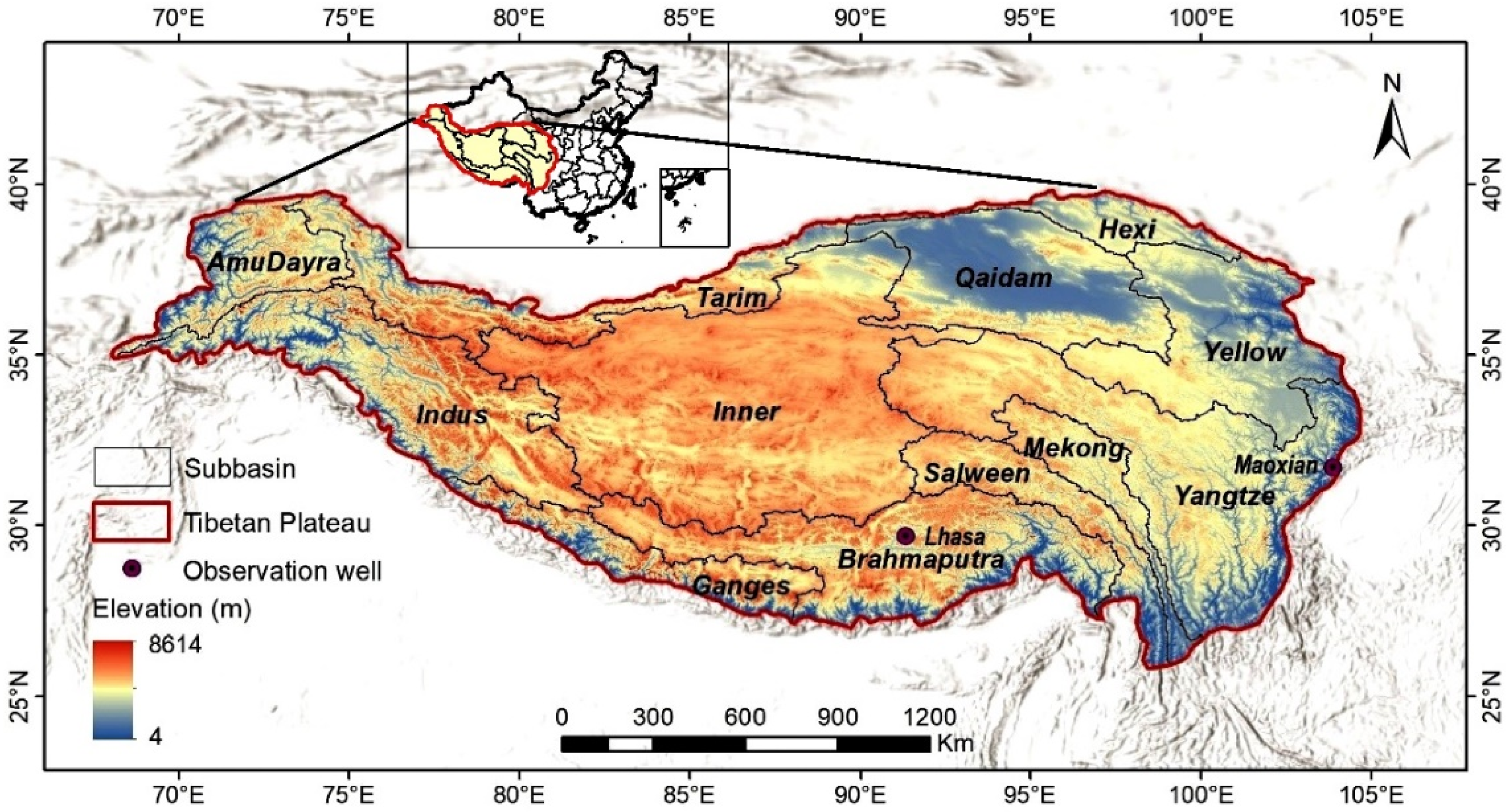


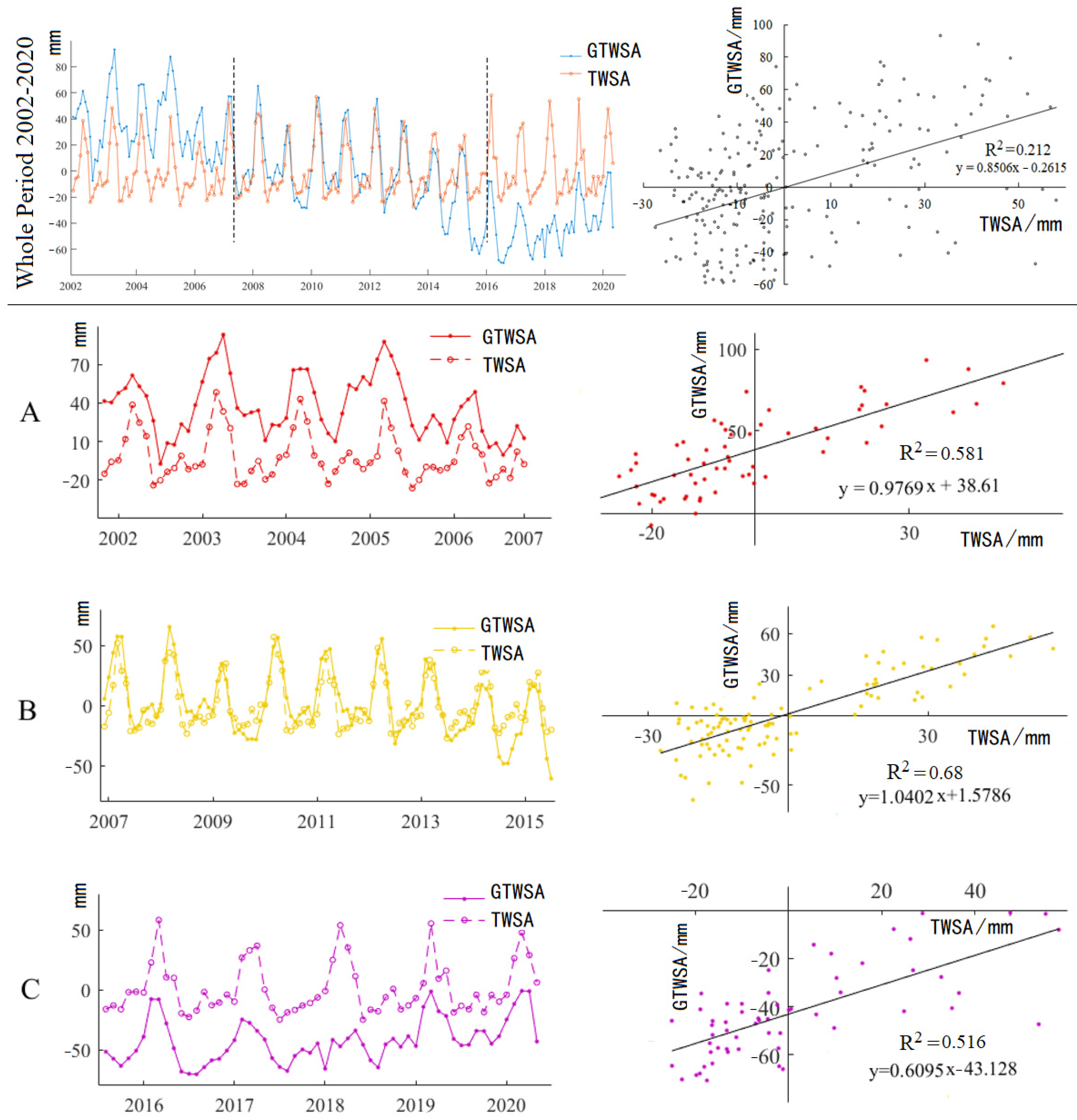
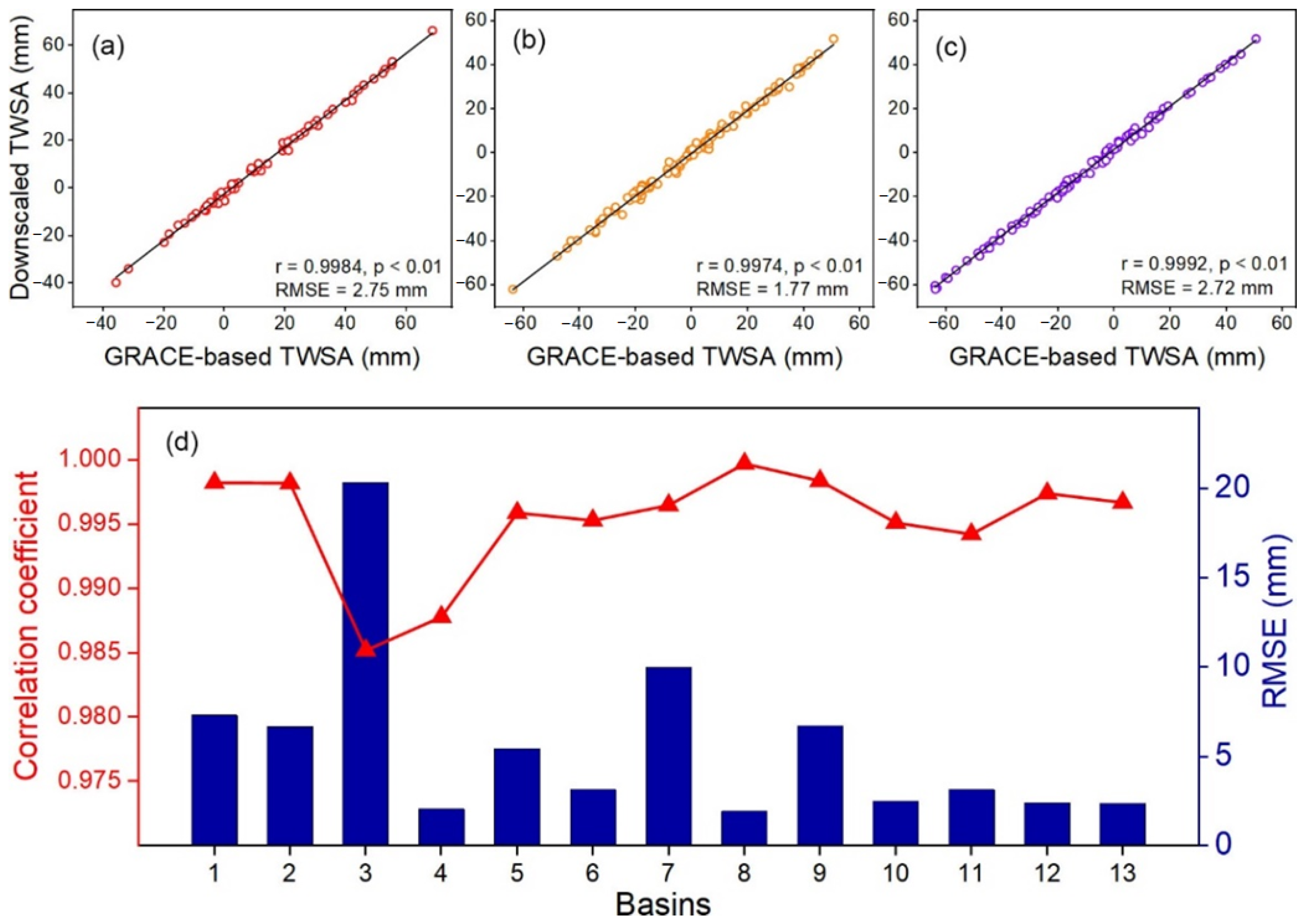


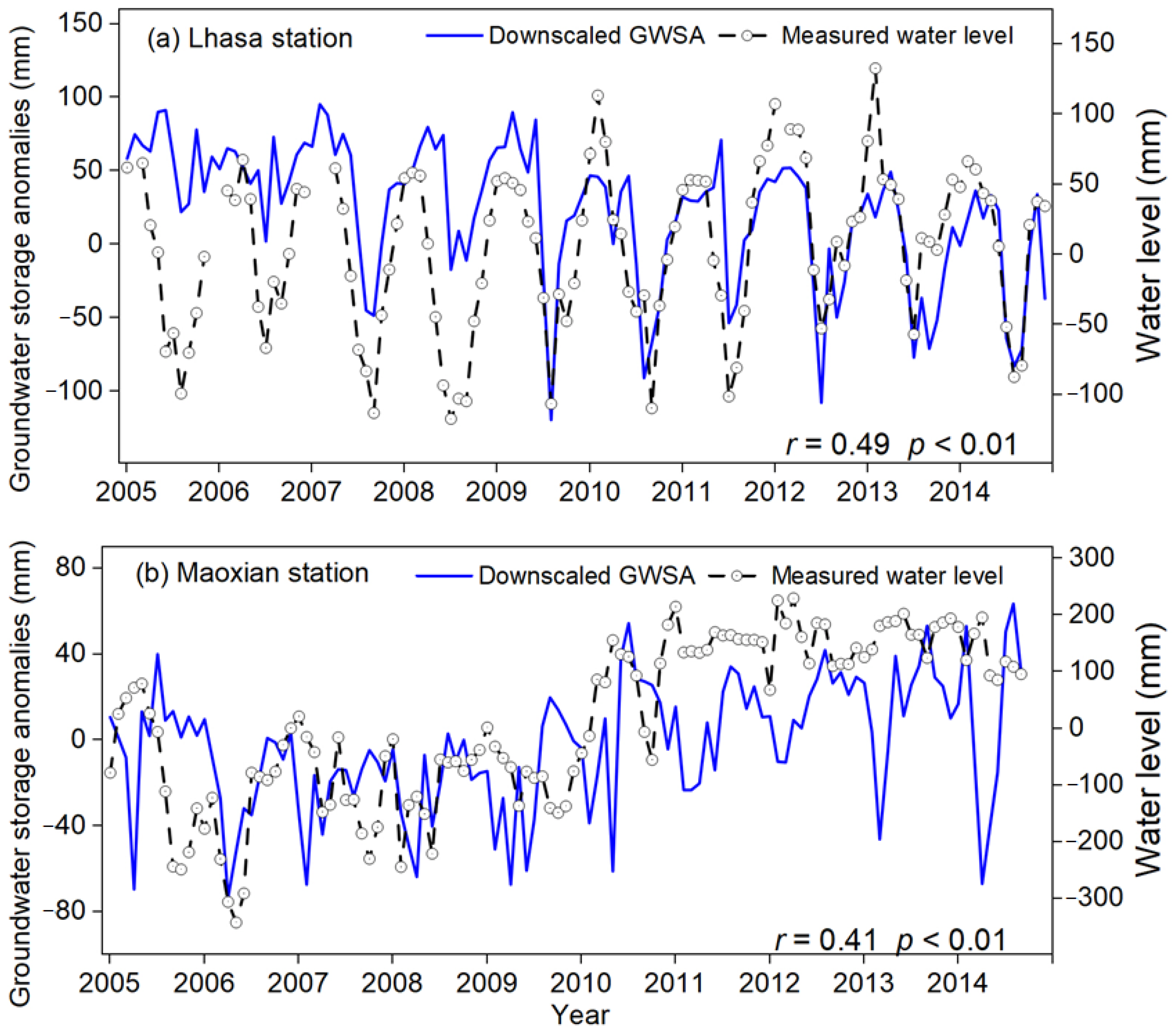

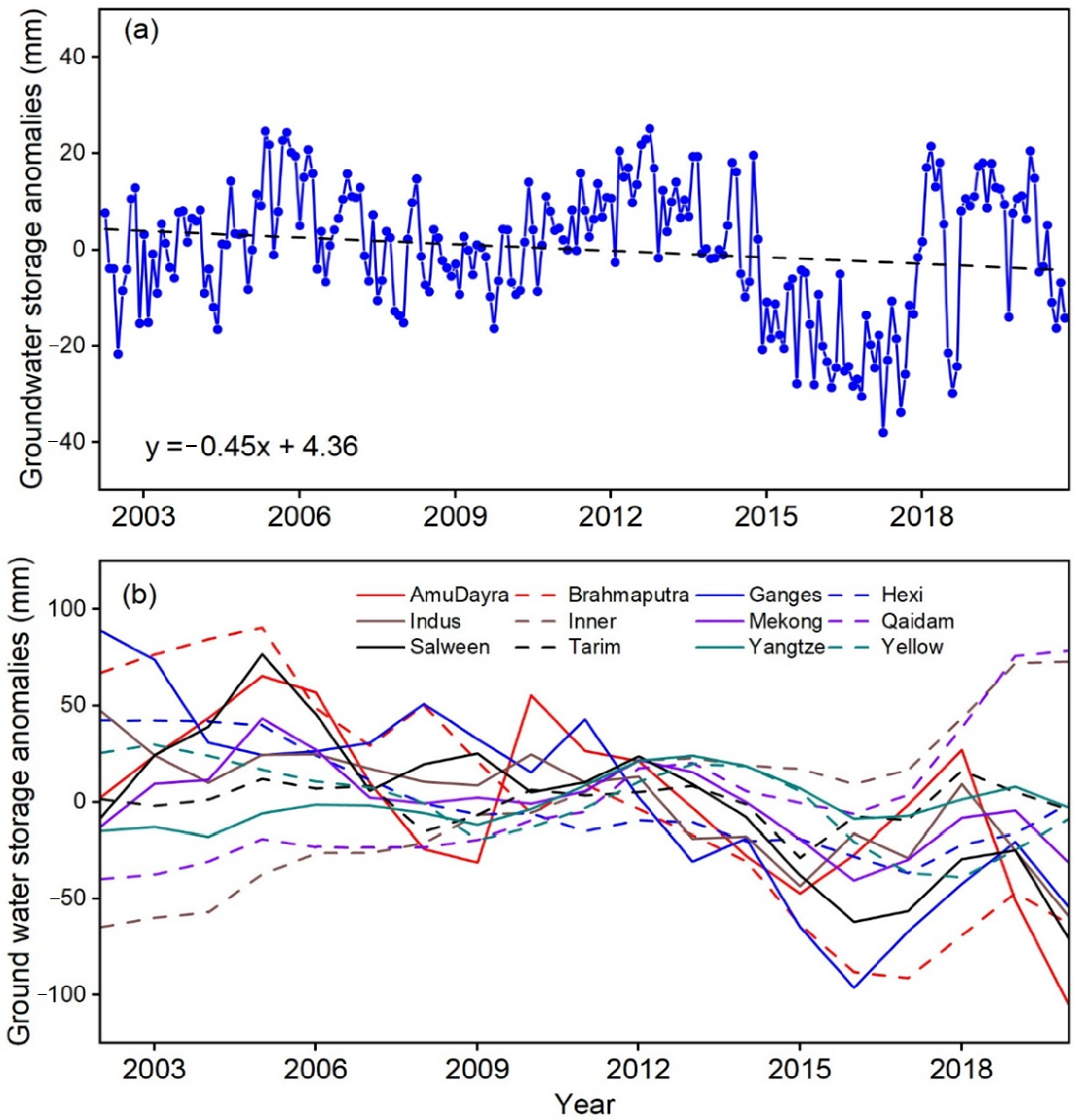


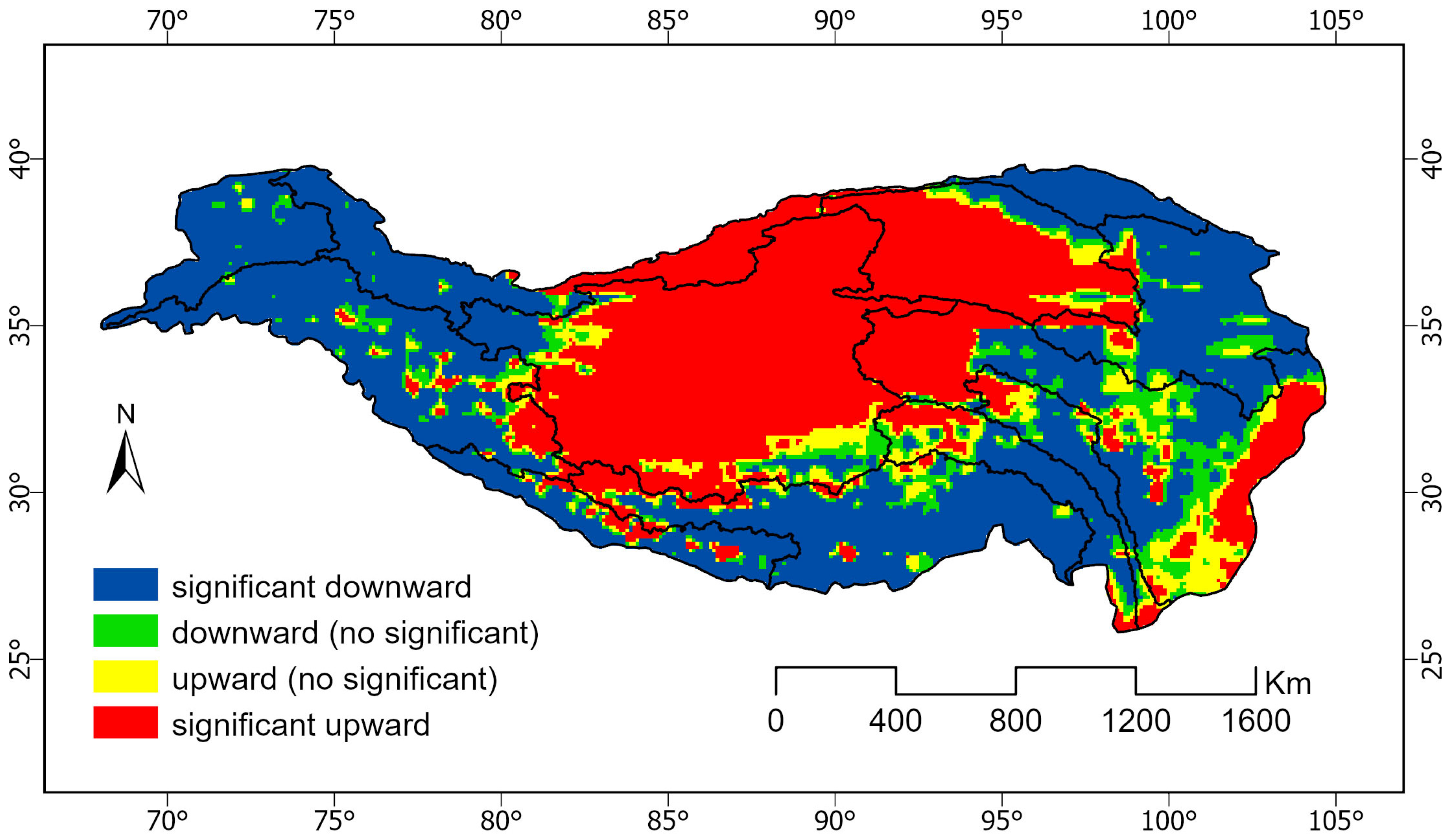

| Climate Factor | Long Name | Data Source |
|---|---|---|
| AOI | Arctic Oscillation Index | https://www.ncdc.noaa.gov/teleconnections/ao/ |
| ENSO | El Nino-Southern Oscillation Index | http://www.esrl.noaa.gov/psd/data/correlation/nina34.data |
| NAOI | North Atlantic Oscillation Index | https:/www.ncdc.noaa.gov/teleconnections/nao/ |
| PDOI | Pacific Decadal Oscillation Index | http://www.ncdc.noaa.gov/teleconnections/pdo/ |
| IMF1 | IMF2 | IMF3 | IMF4 | IMF5 | R | |
|---|---|---|---|---|---|---|
| Period | 0.43 | 0.55 | 1.03 | 2.65 | 4.65 | |
| Variance contribution | 23.14% | 12.59% | 8.58% | 7.42% | 37.58% | 10.70% |
| Correlation coefficient | 0.48 ** | 0.38 ** | 0.30 ** | 0.23 ** | 0.57 ** | 0.27 ** |
| Basins | R2 | Evaporation | Precipitation | Runoff | Night Lights | Natural | Human |
|---|---|---|---|---|---|---|---|
| Tibetan Plateau | 0.08 | 32% | 5% | 24% | 39% | 61% | 39% |
| AmuDayra | 0.32 | 33% | 36% | 11% | 20% | 80% | 20% |
| Brahmaputra | 0.79 | 9% | 11% | 30% | 50% | 50% | 50% |
| Ganges | 0.71 | 29% | 6% | 27% | 39% | 61% | 39% |
| Hexi | 0.69 | 46% | 32% | 3% | 20% | 80% | 20% |
| Indus | 0.73 | 23% | 18% | 15% | 43% | 57% | 43% |
| Inner | 0.83 | 26% | 7% | 32% | 35% | 65% | 35% |
| Mekong | 0.53 | 42% | 2% | 25% | 30% | 70% | 30% |
| Qaidam | 0.89 | 8% | 7% | 24% | 61% | 39% | 61% |
| Salween | 0.67 | 31% | 16% | 20% | 33% | 67% | 33% |
| Tarim | 0.21 | 32% | 11% | 24% | 33% | 67% | 33% |
| Yangtze | 0.41 | 26% | 9% | 17% | 48% | 52% | 48% |
| Yellow | 0.44 | 17% | 38% | 2% | 43% | 57% | 43% |
Publisher’s Note: MDPI stays neutral with regard to jurisdictional claims in published maps and institutional affiliations. |
© 2022 by the authors. Licensee MDPI, Basel, Switzerland. This article is an open access article distributed under the terms and conditions of the Creative Commons Attribution (CC BY) license (https://creativecommons.org/licenses/by/4.0/).
Share and Cite
Gao, G.; Zhao, J.; Wang, J.; Zhao, G.; Chen, J.; Li, Z. Spatiotemporal Variation and Driving Analysis of Groundwater in the Tibetan Plateau Based on GRACE Downscaling Data. Water 2022, 14, 3302. https://doi.org/10.3390/w14203302
Gao G, Zhao J, Wang J, Zhao G, Chen J, Li Z. Spatiotemporal Variation and Driving Analysis of Groundwater in the Tibetan Plateau Based on GRACE Downscaling Data. Water. 2022; 14(20):3302. https://doi.org/10.3390/w14203302
Chicago/Turabian StyleGao, Guangli, Jing Zhao, Jiaxue Wang, Guizhang Zhao, Jiayue Chen, and Zhiping Li. 2022. "Spatiotemporal Variation and Driving Analysis of Groundwater in the Tibetan Plateau Based on GRACE Downscaling Data" Water 14, no. 20: 3302. https://doi.org/10.3390/w14203302
APA StyleGao, G., Zhao, J., Wang, J., Zhao, G., Chen, J., & Li, Z. (2022). Spatiotemporal Variation and Driving Analysis of Groundwater in the Tibetan Plateau Based on GRACE Downscaling Data. Water, 14(20), 3302. https://doi.org/10.3390/w14203302









